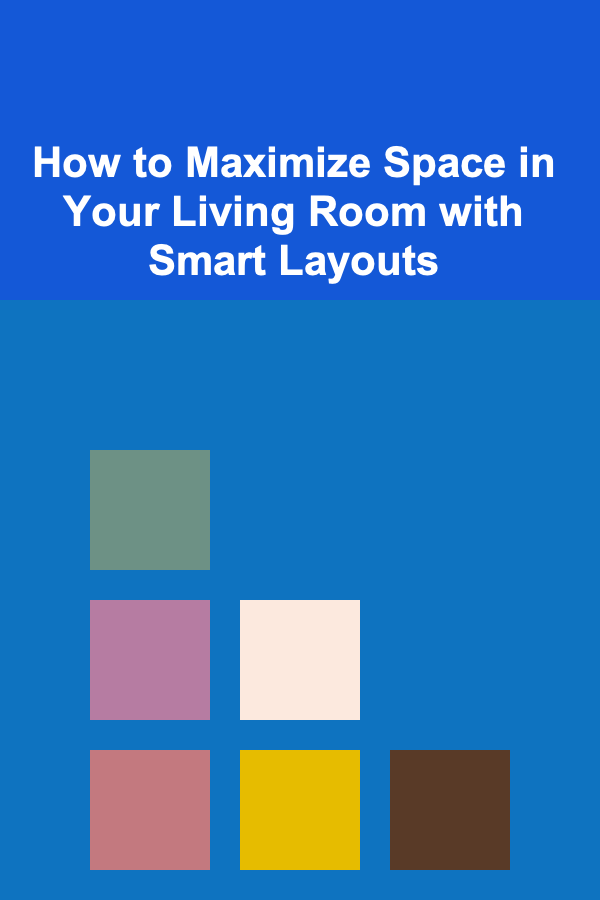
How to Maximize Space in Your Living Room with Smart Layouts
ebook include PDF & Audio bundle (Micro Guide)
$12.99$7.99
Limited Time Offer! Order within the next:

The living room is the heart of the home. It's where we relax after a long day, entertain guests, and spend quality time with family. However, for many of us, the living room can be one of the most challenging spaces to organize. Whether it's a small studio apartment, a large open space, or somewhere in between, figuring out how to make the most of your living room can feel daunting. A well-thought-out layout can make a significant difference in how spacious, functional, and inviting your living room feels.
In this article, we will explore smart strategies for maximizing space in your living room through thoughtful layouts. From selecting the right furniture to optimizing the room's flow, these tips will help you create a living room that is both stylish and functional.
Understand the Space
Before you dive into the design process, take a moment to assess the space you're working with. Every room has its own set of challenges and opportunities, and understanding the size, shape, and features of the room will help guide your layout decisions. Measure your space carefully and pay attention to the following:
- Room Dimensions: Measure the length, width, and height of the room to understand the available space. This will help you decide the size of the furniture pieces you can incorporate.
- Traffic Flow: Consider how you move through the room. There should be clear pathways and enough space for easy movement.
- Windows and Natural Light: Take note of the placement of windows and the direction of natural light. You'll want to arrange your furniture in a way that maximizes light and creates a welcoming atmosphere.
- Focal Points: Identify any natural focal points in the room, such as a fireplace, TV, or artwork. These should influence how you arrange your furniture.
By understanding the specifics of your living room, you can plan a layout that works with the space, rather than against it.
Create Zones Within the Room
One of the most effective ways to maximize space in a living room is by creating distinct zones. Zoning helps to define the purpose of different areas within the room while maintaining a cohesive look. This is particularly important in open-plan spaces where the living room might merge with other areas like the dining room or kitchen.
Key Zones to Consider:
- Seating Area: The seating area is often the focal point of the living room. It's where you'll place the sofa, chairs, and possibly a coffee table. The arrangement of the seating area should encourage conversation and comfort. Make sure there is enough space for people to move around the furniture easily.
- Entertainment Area: If you have a television, consider creating an entertainment zone that is optimized for viewing. Position the TV at an appropriate height and angle to make it visible from the main seating area.
- Reading or Relaxation Nook: If you have the space, consider adding a small reading corner with a comfortable chair, a lamp, and perhaps a small bookshelf. This can provide a quiet retreat within the living room.
- Workspace: In today's home environment, many living rooms also double as home offices. If you work from home, creating a designated workspace can help maintain a clear boundary between relaxation and productivity.
By defining these zones within your living room, you can optimize the use of space while maintaining a sense of order and organization.
Furniture Placement: Focus on Functionality
When it comes to maximizing space in the living room, furniture placement is everything. The arrangement of your furniture can have a significant impact on the flow of the room and how comfortable it feels. Here are some furniture layout tips to help you make the most of your space:
3.1. Floating Furniture Arrangement
A floating furniture arrangement refers to placing furniture away from the walls, creating space in the center of the room. This layout works particularly well in smaller or square-shaped rooms, as it allows for better traffic flow and creates a sense of openness.
For example, you can place a sofa and chairs facing each other, with a coffee table in the middle. This setup encourages conversation and social interaction. It also avoids the feeling of a cramped or overcrowded space, which can happen when furniture is pushed up against the walls.
3.2. Use the Walls for Vertical Storage
When working with limited floor space, it's essential to think vertically. Wall-mounted storage can help free up space on the floor while still providing plenty of room for books, decor, or electronics.
- Wall-Mounted Shelves: Install floating shelves or wall-mounted bookshelves to store books, decorative items, or even small plants.
- Media Units and Cabinets: Consider a media unit with vertical storage or a tall cabinet. These units provide storage without taking up valuable floor space and can help keep the room clutter-free.
By utilizing vertical space for storage, you keep the floor area open and maximize the room's functionality.
3.3. Make the Most of Multi-Functional Furniture
In small living rooms, multi-functional furniture pieces can make a world of difference. Instead of overcrowding the room with numerous separate items, opt for pieces that can serve more than one purpose. Some great options include:
- Sofa Beds: A sofa that doubles as a bed is perfect for small living rooms, especially if you entertain guests frequently.
- Storage Ottomans: An ottoman that also serves as a storage unit can help keep your living room organized while providing extra seating or a footrest.
- Extendable Coffee Tables: A coffee table with adjustable height or expandable features can offer additional storage or serve as a surface for meals or work when needed.
These multi-functional pieces save space and improve the room's practicality.
Choose Furniture That Fits the Room Size
One of the most common mistakes people make when designing a living room layout is choosing furniture that is too large for the space. Oversized furniture can overwhelm a small room and make it feel even more cramped. To avoid this, choose furniture that is proportionate to the size of the room.
- Sofas: Choose a sofa that fits the scale of the room. If your living room is small, a compact sofa or sectional with a low profile will make the room feel more open. Avoid bulky or deep sofas that take up too much space.
- Chairs: Select chairs that are functional and space-efficient. Armless chairs or chairs with thin legs can help make the room feel more spacious.
- Tables: Opt for a coffee table or side tables with a smaller footprint. Consider round tables, which are easier to move around and take up less space visually.
In addition to size, consider the shape of the furniture. In a rectangular room, a sectional sofa can create a cozy and inviting atmosphere. In a square room, a sofa and chairs arranged in a circular or oval shape can create better flow.
Use Mirrors and Light to Create a Sense of Space
Mirrors are one of the oldest tricks in the book when it comes to making a room feel bigger. By reflecting light and giving the illusion of depth, mirrors can significantly enhance the sense of space in a small living room.
5.1. Strategically Place Mirrors
Place mirrors on walls opposite windows or light sources to reflect natural light and brighten up the space. A large mirror can visually expand a room, while smaller mirrors can create the illusion of depth and openness. Mirrors can also be used as decorative elements to add style and interest to your living room.
5.2. Maximize Natural Light
Natural light is essential in creating a spacious and inviting atmosphere. To maximize the amount of light in your living room, avoid heavy curtains or drapes that block the windows. Opt for sheer curtains or blinds that allow light to filter in while still offering privacy. If your room lacks natural light, use bright, neutral colors and add plenty of artificial lighting to keep the space bright and airy.
Maintain an Organized and Clutter-Free Environment
No matter how smart your layout is, a cluttered living room will always feel cramped. To truly maximize space, it's essential to keep the room tidy and organized. Here are some tips to help:
- Hidden Storage: Use furniture pieces with built-in storage, such as ottomans, benches, or cabinets, to store away items like blankets, toys, or books.
- Declutter Regularly: Make it a habit to regularly declutter your living room by removing items that aren't used or necessary. The fewer things you have in the room, the more spacious it will feel.
- Use Baskets and Trays: Keep smaller items organized with decorative baskets or trays. These can be placed on coffee tables or shelves to help maintain a clean, streamlined look.
By keeping your living room organized and free from excess items, you'll create an environment that feels open, peaceful, and more spacious.
Play with Color and Patterns
Color and patterns can have a significant impact on the way a living room feels. Lighter colors, in particular, can make a room feel bigger and more open. Here's how you can use color and patterns to your advantage:
- Light, Neutral Colors: Soft whites, beiges, and light greys can make a small living room feel airy and spacious. These colors also help reflect light, contributing to the overall brightness of the space.
- Accent Walls: If you want to add some boldness to the room, consider creating an accent wall with a darker or more vibrant color. This can add depth to the room without overwhelming it.
- Patterns and Textures: Use patterns and textures strategically to add interest to the room without overcrowding it. Simple geometric patterns or subtle textures on throw pillows, rugs, or curtains can add visual interest while maintaining a sense of space.
Maintain Flow and Balance
Finally, when arranging furniture and decor, make sure that there is a good flow and balance in the room. The layout should encourage natural movement and create a sense of harmony between the furniture and decor. Avoid overcrowding any one area of the room, and make sure that each zone or piece of furniture has enough space to breathe.
Conclusion
Maximizing space in your living room requires a combination of thoughtful planning, smart furniture choices, and design techniques. By understanding the dimensions of your space, creating zones, using multi-functional furniture, and utilizing light and mirrors, you can make the most of your living room, no matter its size. With the right layout and design, your living room can feel open, inviting, and perfectly suited to your needs.
Reading More From Our Other Websites
- [Home Party Planning 101] How to Plan a Spa Day Party at Home for Friends
- [Personal Investment 101] How to Earn Money by Licensing Deep Learning Algorithms
- [Home Rental Property 101] How to Maintain and Market Houses for Rent with a Pool
- [Personal Care Tips 101] How to Use Teeth Whitening Strips for Sensitive Teeth
- [Digital Decluttering Tip 101] Daily Digital Habits That Boost Productivity and Reduce Stress
- [Screen Printing Tip 101] Best Safety Protocols for Handling Hazardous Chemicals in Screen‑Printing Environments
- [Organization Tip 101] Safety Tips for Using Backyard Fire Pit Kits
- [Home Lighting 101] How to Choose the Best Light Bulbs for Your Home Lighting Needs
- [Home Lighting 101] How to Create a Cozy Reading Nook with Safavieh Floor Lamps
- [Digital Decluttering Tip 101] How to Automate Document Management with AI and Cloud Tools

How to Create a Calm and Focused Atmosphere
Read More
How to Create a Pet Safety Plan for Emergencies at Home
Read More
How to Use Repurposed Containers for Craft Organization
Read More
Building a Relationship That Lasts a Lifetime
Read More
How to Optimize Your React Application for Performance
Read More
How to Navigate Copyright Law as a Librarian
Read MoreOther Products

How to Create a Calm and Focused Atmosphere
Read More
How to Create a Pet Safety Plan for Emergencies at Home
Read More
How to Use Repurposed Containers for Craft Organization
Read More
Building a Relationship That Lasts a Lifetime
Read More
How to Optimize Your React Application for Performance
Read More